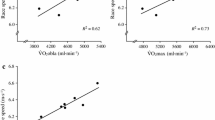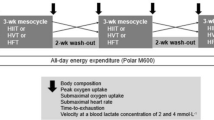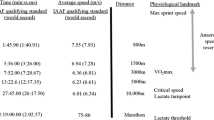Abstract
Purpose
The present study identified the physiological and performance characteristics that are deterministic during a maximal 1500-m time trial and in paced 1500-m time trials, with an all-out last lap.
Methods
Thirty-two trained middle-distance runners (n = 21 male, VO2peak: 72.1 ± 3.2; n = 11, female, VO2peak: 61.2 ± 3.7 mL kg−1 min−1) completed a 1500-m time trial in the fastest time possible (1500FAST) as well as a 1500MOD and 1500SLOW trial whereby mean speed was reduced during the 0–1100 m by 5% and 10%, respectively. Anaerobic speed reserve (ASR), running economy (RE), the velocity corresponding with VO2peak (VVO2peak), maximal sprint speed (MSS) and maximal accumulated oxygen deficit (MAOD) were determined during additional testing. Carnosine content was quantified by proton magnetic resonance spectroscopy in the gastrocnemius and expressed as a Z-score to estimate muscle fibre typology.
Results
1500FAST time was best explained by RE and VVO2peak in female runners (adjusted r2 = 0.80, P < 0.001), in addition to the 0–1100-m speed relative to VVO2peak in male runners (adjusted r2 = 0.72, P < 0.001). Runners with a higher gastrocnemius carnosine Z-score (i.e., higher estimated percentage of type II fibres) and greater MAOD, reduced their last lap time to a greater extent in the paced 1500-m trials. Neither ASR nor MSS was associated with last lap time in the paced trials.
Conclusion
These findings suggest that VVO2 peak and RE are key determinants of 1500-m running performance with a sustained pace from the start, while a higher carnosine Z-score and MAOD are more important for last lap speed in tactical 1500-m races.





Similar content being viewed by others
Abbreviations
- RE:
-
Running economy
- VVO2peak :
-
Minimal velocity that elicits VO2peak
- ASR:
-
Anaerobic speed reserve
- MSS:
-
Maximal sprinting speed
- CS:
-
Critical speed
- D’:
-
Curvature constant
- VO2peak :
-
Peak oxygen uptake
- 1500FAST :
-
Maximal 1500-m time trial
- 1500MOD :
-
Moderately paced 1500-m time trial
- 1500SLOW :
-
Slow-paced 1500-m time trial
- MAOD:
-
Maximal accumulated oxygen deficit
- d :
-
Distance run
- t:
-
Time
- CV:
-
Coefficient of variation
- VO2 :
-
Oxygen uptake
- GET:
-
Gas exchange threshold
- TTE:
-
Time to exhaustion
- 1H-MRS:
-
Proton magnetic resonance spectroscopy
- MRI:
-
Magnetic resonance imaging
- SD:
-
Standard deviation
References
Bachero-Mena B, Pareja-Blanco F, Rodríguez-Rosell D, Yáñez-García JM, Mora-Custodio R, González-Badillo JJ (2017) Relationships between sprint, jumping and strength abilities, and 800 m performance in male athletes of national and international levels. J Hum Kinet 58(1):187–195. https://doi.org/10.1515/hukin-2017-0076
Baguet A, Everaert I, Hespel P, Petrovic M, Achten E, Derave W (2011) A new method for non-invasive estimation of human muscle fiber type composition. PLoS ONE 6(7):e21956. https://doi.org/10.1371/journal.pone.0021956
Billat LV (2001) Interval training for performance: a scientific and empirical practice. Sports Med 31(1):13–31. https://doi.org/10.2165/00007256-200131010-00002
Billat V, Beillot J, Jan J, Rochcongar P, Carre F (1996) Gender effect on the relationship of time limit at 100% VO2max with other bioenergetic characteristics. Med Sci Sports Exerc 28(8):1049–1055. https://doi.org/10.1097/00005768-199608000-00016
Billat V, Hamard L, Koralsztein JP, Morton RH (2009) Differential modeling of anaerobic and aerobic metabolism in the 800-m and 1,500-m run. J Appl Physiol 107(2):478–487. https://doi.org/10.1152/japplphysiol.91296.2008
Blondel N, Berthoin S, Billat V, Lensel G (2001) Relationship between run times to exhaustion at 90, 100, 120, and 140% of vVO2max and velocity expressed relatively to critical velocity and maximal velocity. Int J Sports Med 22(1):27–33. https://doi.org/10.1055/s-2001-11357
Bosco C, Montanari G, Ribacchi R, Giovenali P, Latteri F, Iachelli G, Faina M, Colli R, Dal Monte A, La Rosa M, Cortili G, Saibene F (1987) Relationship between the efficiency of muscular work during jumping and the energetics of running. Eur J Appl Physiol Occup Physiol 56(2):138–143. https://doi.org/10.1007/BF00640636
Bottinelli R, Reggiani C (2000) Human skeletal muscle fibres: molecular and functional diversity. Prog Biophys Mol Biol 73(2):195–262. https://doi.org/10.1016/S0079-6107(00)00006-7
Bundle MW, Weyand PG (2012) Sprint exercise performance: does metabolic power matter? Exerc Sport Sci Rev 40(3):174–182. https://doi.org/10.1097/JES.0b013e318258e1c1
Bundle MW, Hoyt RW, Weyand PG (2003) High-speed running performance: a new approach to assessment and prediction. J Appl Physiol 95(5):1955–1962. https://doi.org/10.1152/japplphysiol.00921.2002
Casado A, Renfree A (2018) Fortune favors the brave: tactical behaviors in the middle-distance running events at the 2017 IAAF World Championships. Int J Sports Physiol Perform 13(10):1386–1391. https://doi.org/10.1123/ijspp.2018-0055
Costill DL, Daniels J, Evans W, Fink W, Krahenbuhl G, Saltin B (1976) Skeletal muscle enzymes and fiber composition in male and female track athletes. J Appl Physiol 40(2):149–154. https://doi.org/10.1152/jappl.1976.40.2.149
Duffield R, Dawson B, Goodman C (2005) Energy system contribution to 1500- and 3000-metre track running. J Sports Sci 23(10):993–1002. https://doi.org/10.1080/02640410400021963
Ferri A, Adamo S, La Torre A, Marzorati M, Bishop DJ, Miserocchi G (2012) Determinants of performance in 1,500-m runners. Eur J Appl Physiol 112(8):3033–3043. https://doi.org/10.1007/s00421-011-2251-2
Fletcher JR, Esau SP, MacIntosh BR (2009) Economy of running: beyond the measurement of oxygen uptake. J Appl Physiol 107(6):1918–1922. https://doi.org/10.1152/japplphysiol.00307.2009
Gaesser GA, Poole DC (1996) The slow component of oxygen uptake kinetics in humans. Exerc Sport Sci Rev 24(1):35–70
Hanley B, Stellingwerff T, Hettinga FJ (2019) Successful pacing profiles of Olympic and IAAF World Championship middle-distance runners across qualifying rounds and finals. Int J Sports Physiol Perform 14(7):894–901. https://doi.org/10.1123/ijspp.2018-0742
Harber MP, Gallagher PM, Creer AR, Minchev KM, Trappe SW (2004) Single muscle fiber contractile properties during a competitive season in male runners. Am J Physiol Regul Integr Comp Physiol 287(5):R1124–R1131. https://doi.org/10.1152/ajpregu.00686.2003
Hill DW, Smith JC (1993) A comparison of methods of estimating anaerobic work capacity. Ergonomics 36(12):1495–1500. https://doi.org/10.1080/00140139308968017
Hughson R, Orok C, Staudt L (1984) A high velocity treadmill running test to assess endurance running potential. Int J Sports Med 5(01):23–25. https://doi.org/10.1055/s-2008-1025875
Ingalls CP (2004) Nature vs. nurture: can exercise really alter fiber type composition in human skeletal muscle? J Appl Physiol 97(5):1591–1592. https://doi.org/10.1152/classicessays.00010.2004
Ingham SA, Whyte GP, Pedlar C, Bailey DM, Dunman N, Nevill AM (2008) Determinants of 800-m and 1500-m running performance using allometric models. Med Sci Sport Exerc 40(2):345–350. https://doi.org/10.1249/mss.0b013e31815a83dc
Iwaoka K, Hatta H, Atomi Y, Miyashita M (1988) Lactate, respiratory compensation thresholds, and distance running performance in runners of both sexes. Int J Sports Med 09(05):306–309. https://doi.org/10.1055/s-2007-1025028
Jansson E, Kaijser L (1977) Muscle adaptation to extreme endurance training in man. Acta Physiol Scand 100(3):315–324. https://doi.org/10.1111/j.1748-1716.1977.tb05956.x
Jones AM, Doust JH (1996) A 1% treadmill grade most accurately reflects the energetic cost of outdoor running. J Sports Sci 14(4):321–327. https://doi.org/10.1080/02640419608727717
Jones AM, Whipp BJ (2002) Bioenergetic constraints on tactical decision making in middle distance running. Br J Sports Med 36(2):102–104. https://doi.org/10.1136/bjsm.36.2.102
Kyrolainen H, Kivela R, Koskinen S, McBride J, Andersen JL, Takala T, Sipila S, Komi PV (2003) Interrelationships between muscle structure, muscle strength, and running economy. Med Sci Sports Exerc 35(1):45–49. https://doi.org/10.1249/01.mss.0000046149.03322.bb
MacMillan EL, Bolliger CS, Boesch C, Kreis R (2016) Influence of muscle fiber orientation on water and metabolite relaxation times, magnetization transfer, and visibility in human skeletal muscle. Magn Reson Med 75(4):1764–1770. https://doi.org/10.1002/mrm.25778
Medbo JI, Mohn AC, Tabata I, Bahr R, Vaage O, Sejersted OM (1988) Anaerobic capacity determined by maximal accumulated O2 deficit. J Appl Physiol 64(1):50–60. https://doi.org/10.1152/jappl.1988.64.1.50
Monod H, Scherrer J (1965) The work capacity of a synergic muscular group. Ergonomics 8(3):329–338. https://doi.org/10.1080/00140136508930810
Morgan DW, Baldini FD, Martin PE, Kohrt WM (1989) Ten kilometer performance and predicted velocity at VO2max among well-trained male runners. Med Sci Sports Exerc 21(1):78–83. https://doi.org/10.1249/00005768-198902000-00014
Murgatroyd SR, Ferguson C, Ward SA, Whipp BJ, Rossiter HB (2011) Pulmonary O2 uptake kinetics as a determinant of high-intensity exercise tolerance in humans. J Appl Physiol 110(6):1598–1606. https://doi.org/10.1152/japplphysiol.01092.2010
Mytton GJ, Archer DT, Turner L, Skorski S, Renfree A, Thompson KG, Gibson ASC (2015) Increased variability of lap speeds: differentiating medalists and nonmedalists in middle-distance running and swimming events. Int J Sports Physiol Perform 10(3):369–373. https://doi.org/10.1123/ijspp.2014-0207
Ørtenblad N, Nielsen J, Boushel R, Söderlund K, Saltin B, Holmberg H-C (2018) The muscle fiber profiles, mitochondrial content, and enzyme activities of the exceptionally well-trained arm and leg muscles of elite cross-country skiers. Front Physiol. https://doi.org/10.3389/fphys.2018.01031
Parkhouse WS, McKenzie DC, Hochachka PW, Ovalle WK (1985) Buffering capacity of deproteinized human vastus lateralis muscle. J Appl Physiol 58(1):14–17. https://doi.org/10.1152/jappl.1985.58.1.14
Peronnet F, Massicotte D (1991) Table of nonprotein respiratory quotient: an update. Can J Sport Sci 16(1):23–29
Pette D (1985) Metabolic heterogeneity of muscle fibres. J Exp Biol 115(1):179–189
Pettitt RW (2016) Applying the critical speed concept to racing strategy and interval training prescription. Int J Sports Physiol Perform 11(7):842–847. https://doi.org/10.1123/ijspp.2016-0001
Pringle JSM, Doust JH, Carter H, Tolfrey K, Campbell IT, Jones AM (2003) Oxygen uptake kinetics during moderate, heavy and severe intensity “submaximal” exercise in humans: the influence of muscle fibre type and capillarisation. Eur J Appl Physiol 89(3):289–300. https://doi.org/10.1007/s00421-003-0799-1
Salam H, Marcora SM, Hopker JG (2018) The effect of mental fatigue on critical power during cycling exercise. Eur J Appl Physiol 118(1):85–92. https://doi.org/10.1007/s00421-017-3747-1
Sandford GN, Allen SV, Kilding AE, Ross A, Laursen PB (2018) Anaerobic speed reserve: a key component of elite male 800m running. Int J Sports Physiol Perform 14(4):501–508. https://doi.org/10.1123/ijspp.2018-0163
Sandford GN, Day BT, Rogers SA (2019a) Racing fast and slow: defining the tactical behavior that differentiates medalists in elite men’s 1,500 m championship racing. Front Sports Act Living. https://doi.org/10.3389/fspor.2019.00043
Sandford GN, Kilding AE, Ross A, Laursen PB (2019b) Maximal sprint speed and the anaerobic speed reserve domain: the untapped tools that differentiate the world’s best male 800 m runners. Sports Med 49(6):843–852. https://doi.org/10.1007/s40279-018-1010-5
Sandford GN, Rogers SA, Sharma AP, Kilding AE, Ross A, Laursen PB (2019c) Implementing anaerobic speed reserve testing in the field: validation of vVO2max prediction from 1500-m race performance in elite middle-distance runners. Int J Sports Physiol Perform 14(8):1147–1150. https://doi.org/10.1123/ijspp.2018-0553
Schneider DA, Phillips SE, Stoffolano S (1993) The simplified V-slope method of detecting the gas exchange threshold. Med Sci Sports Exerc 25(10):1180–1184
Spencer MR, Gastin PB (2001) Energy system contribution during 200-to 1500-m running in highly trained athletes. Med Sci Sport Exerc 33(1):157–162. https://doi.org/10.1097/00005768-200101000-00024
Tesch PA, Thorsson A, Fujitsuka N (1989) Creatine phosphate in fiber types of skeletal muscle before and after exhaustive exercise. J Appl Physiol 66(4):1756–1759. https://doi.org/10.1152/jappl.1989.66.4.1756
Tsuji K, Ishida H, Oba K, Ueki T, Fujihashi Y (2015) Activity of lower limb muscles during treadmill running at different velocities. J Phys Ther Sci 27(2):353–356. https://doi.org/10.1589/jpts.27.353
Tucker R, Lambert MI, Noakes TD (2006) An analysis of pacing strategies during men’s world-record performances in track athletics. Int J Sports Physiol Perform 1(3):233–245. https://doi.org/10.1123/ijspp.1.3.233
Vanhatalo A, Fulford J, DiMenna FJ, Jones AM (2010) Influence of hyperoxia on muscle metabolic responses and the power–duration relationship during severe-intensity exercise in humans: a 31P magnetic resonance spectroscopy study. Exp Physiol 95(4):528–540. https://doi.org/10.1113/expphysiol.2009.050500
Ward-Smith AJ (1999) The bioenergetics of optimal performances in middle-distance and long-distance track running. J Biomech 32(5):461–465. https://doi.org/10.1016/S0021-9290(99)00029-9
Author information
Authors and Affiliations
Contributions
PB, WD, EL, BA and CM conceived and designed research. PB, BK, HR and BA conducted experiments. WD and EL analysed 1H-MRS data. PB analysed training and performance data. PB wrote the manuscript. All authors read and approved the manuscript.
Corresponding author
Ethics declarations
Conflict of interest
The authors declare that we received internal funding from Griffith University which supported MR related costs for the data collection. The authors have no competing financial or non-financial interests to disclose. The results of the present study are presented clearly, honestly, and without fabrication.
Additional information
Communicated by Philip D. Chilibeck.
Publisher's Note
Springer Nature remains neutral with regard to jurisdictional claims in published maps and institutional affiliations.
Rights and permissions
About this article
Cite this article
Bellinger, P., Derave, W., Lievens, E. et al. Determinants of last lap speed in paced and maximal 1500-m time trials. Eur J Appl Physiol 121, 525–537 (2021). https://doi.org/10.1007/s00421-020-04543-x
Received:
Accepted:
Published:
Issue Date:
DOI: https://doi.org/10.1007/s00421-020-04543-x




